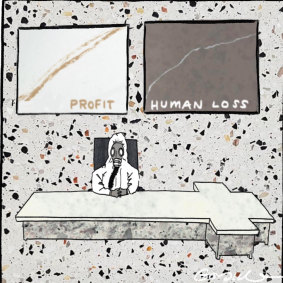- Analysis
- Politics
- Federal
- The Dust of Death
This was published 2 years ago
Progress on a benchtop ban sounds good on the surface, but don’t ignore the fine print
How much for a human life? It’s an uncomfortable question state and federal ministers have been forced to finally address as they grapple with the truth that Australia’s obsession with shiny kitchen benchtops is driving a silicosis epidemic.
As stonemason Ken Parker told the Herald, The Age and 60 Minutes, engineered benchtops are “straight up killing people” and the only way to stop it is to ban it. Parker has more at stake than most; in November 2019 the father of two was diagnosed with silicosis and given a life expectancy of five to 10 years.
A ban sounds straightforward, and federal Workplace Relations Minister Tony Burke certainly portrayed it that way on Tuesday when he used the analogy that if a children’s toy was harming or killing kids, “we’d take it off the shelves”.
But when hundreds of millions of dollars are involved, complications - and compromises - inevitably arise. Burke rightly pointed out the stain on this country’s work, health and safety record when it comes to the decades it took to ban asbestos, despite knowing its dangers. He said he didn’t want the same thing to happen with engineered stone.
On Tuesday, the states, territories and Commonwealth agreed to fast-track by 17 months what a ban on engineered stone would look like. They also agreed on other areas of reform such as a national awareness campaign and refreshing the codes of practice for at-risk industries.
On the surface it all sounds good. Safe Work Australia, the national safety policymaking agency, has been tasked to present a report within six months and draft regulations by the end of the year. This would include consideration of silica content levels and consideration of a national licensing system for products that are not subject to a ban.
Safe Work has recommended a new education and awareness campaign and better regulation of silica dust across all industries. Burke would also explore an import ban on engineered stone in consultation with the states and stakeholders on the effects of a ban.
But the real question is what tangible difference these measures will make to workers currently exposed to crystalline silica in their workplaces. What exactly will the final ban look like, if it happens? When will change actually occur? And will it be enough to stop the deaths?
The evidence of workplace regulator incompetence is undisputed - particularly in NSW - and even if this process results in the strongest regulations in the world, nothing will change without proper enforcement.
It is why a mandatory licensing scheme and register for all businesses that handle engineered stone or products with high levels of silica must be front and centre of whatever happens.
Victoria’s licensing scheme has helped hold business to account and allowed that state’s safety regulator to track where the workers are. This is something the other states don’t have, which has made it difficult to screen workers for silicosis.
It means some operators have been able to fly under the radar. Some businesses hire foreign workers to do the jobs. Buses take them to the worksites and if they get sick, they are returned to their home country to die. These workers are too scared to come forward, requesting confidentiality, for fear of being deported.
Safe Work Australia has been anointed to do the heavy lifting to develop policies to eliminate silicosis and silica-related diseases. But its poor track record, slowness to act and inability to develop meaningful policy or push the states to urgently deal with the crisis is a worry.

Credit: Matt Golding
Since the Herald, The Age and 60 Minutes exposed the scale of the problem last week, industry and suppliers have spun the line that a ban would disrupt construction. It is this type of powerful lobbying that has spooked lawmakers for years to sit in silence. It is an argument that has previously won the day at Safe Work.
Not surprisingly, manufactured stone suppliers that have continued to create products with high silica levels are the loudest voices in trying to stop a ban. However, the dangers of these products have been known for decades, but the warnings were underplayed and the option to reduce the levels of silica in the slabs from current levels of up to 95 per cent were largely ignored.
At the end of the day, engineered stone benchtops are vanity products. There are alternatives like marble, granite and wood. There are even some engineered stone products that contain less than 40 per cent silica such as Cosentino Group’s Silestone product, which the firm claims there is enough supply of in Australia to avoid any supply disruption to the construction markets.
What workers need is immediate action. A ban on manufactured stone which contains levels higher than 40 per cent would be a good start, along with a mandatory licensing scheme and regulators that do their job.
For workers like Parker who is dying of silicosis, there has been enough talk, enough inquiries and enough recommendations from bodies like Safe Work Australia, which until now have done little except kick the problem down the road.
Our Breaking News Alert will notify you of significant breaking news when it happens. Get it here.